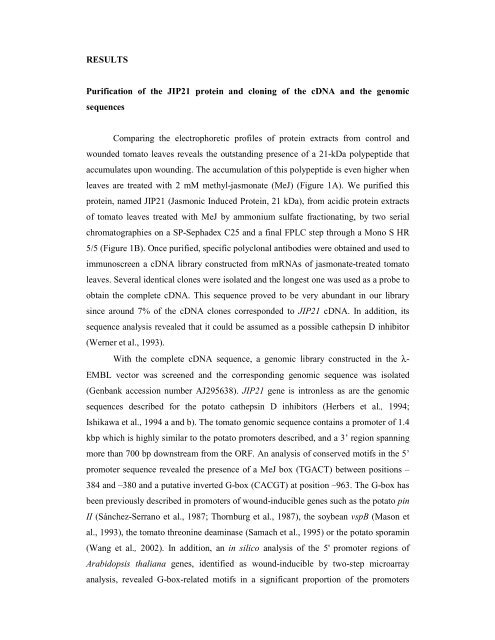Tomato CDI as a Strong Chymotrypsin Inhibitor ... - Plant Physiology
Tomato CDI as a Strong Chymotrypsin Inhibitor ... - Plant Physiology
Tomato CDI as a Strong Chymotrypsin Inhibitor ... - Plant Physiology
You also want an ePaper? Increase the reach of your titles
YUMPU automatically turns print PDFs into web optimized ePapers that Google loves.
RESULTS<br />
Purification of the JIP21 protein and cloning of the cDNA and the genomic<br />
sequences<br />
Comparing the electrophoretic profiles of protein extracts from control and<br />
wounded tomato leaves reveals the outstanding presence of a 21-kDa polypeptide that<br />
accumulates upon wounding. The accumulation of this polypeptide is even higher when<br />
leaves are treated with 2 mM methyl-j<strong>as</strong>monate (MeJ) (Figure 1A). We purified this<br />
protein, named JIP21 (J<strong>as</strong>monic Induced Protein, 21 kDa), from acidic protein extracts<br />
of tomato leaves treated with MeJ by ammonium sulfate fractionating, by two serial<br />
chromatographies on a SP-Sephadex C25 and a final FPLC step through a Mono S HR<br />
5/5 (Figure 1B). Once purified, specific polyclonal antibodies were obtained and used to<br />
immunoscreen a cDNA library constructed from mRNAs of j<strong>as</strong>monate-treated tomato<br />
leaves. Several identical clones were isolated and the longest one w<strong>as</strong> used <strong>as</strong> a probe to<br />
obtain the complete cDNA. This sequence proved to be very abundant in our library<br />
since around 7% of the cDNA clones corresponded to JIP21 cDNA. In addition, its<br />
sequence analysis revealed that it could be <strong>as</strong>sumed <strong>as</strong> a possible cathepsin D inhibitor<br />
(Werner et al., 1993).<br />
With the complete cDNA sequence, a genomic library constructed in the λ-<br />
EMBL vector w<strong>as</strong> screened and the corresponding genomic sequence w<strong>as</strong> isolated<br />
(Genbank accession number AJ295638). JIP21 gene is intronless <strong>as</strong> are the genomic<br />
sequences described for the potato cathepsin D inhibitors (Herbers et al., 1994;<br />
Ishikawa et al., 1994 a and b). The tomato genomic sequence contains a promoter of 1.4<br />
kbp which is highly similar to the potato promoters described, and a 3’ region spanning<br />
more than 700 bp downstream from the ORF. An analysis of conserved motifs in the 5’<br />
promoter sequence revealed the presence of a MeJ box (TGACT) between positions –<br />
384 and –380 and a putative inverted G-box (CACGT) at position –963. The G-box h<strong>as</strong><br />
been previously described in promoters of wound-inducible genes such <strong>as</strong> the potato pin<br />
II (Sánchez-Serrano et al., 1987; Thornburg et al., 1987), the soybean vspB (M<strong>as</strong>on et<br />
al., 1993), the tomato threonine deamin<strong>as</strong>e (Samach et al., 1995) or the potato sporamin<br />
(Wang et al., 2002). In addition, an in silico analysis of the 5' promoter regions of<br />
Arabidopsis thaliana genes, identified <strong>as</strong> wound-inducible by two-step microarray<br />
analysis, revealed G-box-related motifs in a significant proportion of the promoters

















